September 2015
Safety
Proper and appropriate training is simply critical to avoiding falls and other injuries.
By Jim Cook
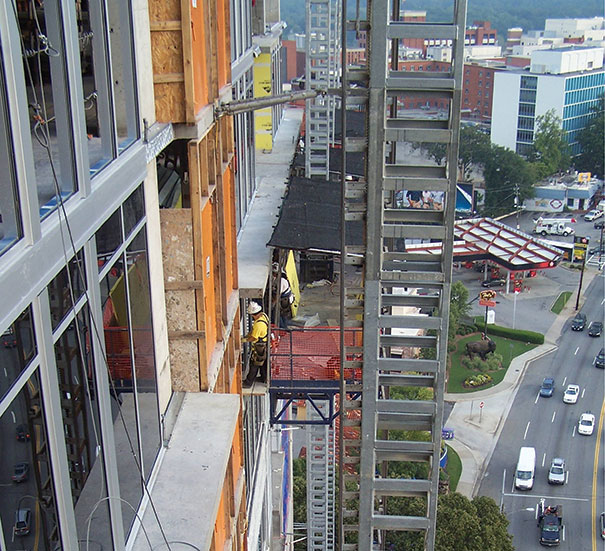
Image courtesy of EZ Scaffold
Training, meticulous adherence to safety guidelines and situational awareness all contribute to preventing tragedies on jobsites, particularly those involving working at heights. A recent fatal accident in North Carolina illustrates the need for emphasis on safety standards among masons and other construction workers using scaffolding and mast climbers in high-rise construction projects.
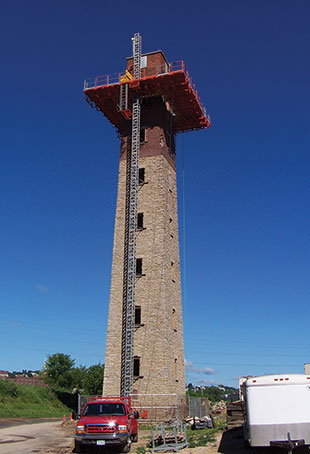 Three men were killed and a fourth seriously injured in March, when a mast climber fell and sent a mobile scaffolding platform plummeting to the ground. The accident occurred in Raleigh, N.C., while the workers were disassembling the device. Although the cause of the accident remains under investigation, it has sparked conversation in the masonry and construction industries regarding the need for continued progress on safety issues.
Three men were killed and a fourth seriously injured in March, when a mast climber fell and sent a mobile scaffolding platform plummeting to the ground. The accident occurred in Raleigh, N.C., while the workers were disassembling the device. Although the cause of the accident remains under investigation, it has sparked conversation in the masonry and construction industries regarding the need for continued progress on safety issues.
“If manufacturers or distributors of mast climbers aren’t training these guys or if contractors aren’t enforcing safety, you’re going to have a problem,” says Jim Stanley, president of FDR Safety.
Masons are increasingly using scaffolds and mast climbers as the economy rebounds and construction resumes on high-rise buildings and other multi-story construction projects. Mast climbers are gaining popularity in the industry, because their adjustable height makes work easier and faster for masons.
With a mast climber, workers can be elevated to the optimum working height for laying brick, allowing masons to work faster and with less strain on their arms and backs. Mast climbers also have large load capacity, helping reduce the number of trips up and down needed to transport materials. A 2010 Center for Construction Research and Training study found that 70 percent of masonry contractors surveyed said that increased productivity was the greatest advantage of mast climbers.
While scaffolding and mast climbers are indispensible tools to the masonry industry, they can also pose hazards to laborers if contractors and workers don’t maintain proper safety standards. OSHA handed out more than 5,400 citations involving scaffold and mast climber violations last year. According to the Center for Construction Research and Training report, Bureau of Labor Statistics and OSHA numbers indicate that masonry is the trade that experiences the most fatalities involving mast climbers. Plasterers and glaziers are the No. 2 and No. 3 trades with regard to mast climber-related fatalities.
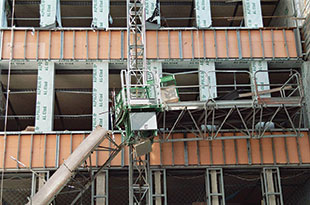
Image courtesy of EZ Scaffold
Common safety issues
OSHA data says that most accidents involving scaffolding and mast climbers involves planking or other support giving way, workers slipping or workers being struck by falling objects.
According to Michael D’Aquino, an OSHA spokesperson, masons have to comply with 29 CFR Part 1926, Subpart L – Scaffolds, when using scaffolds and mast climbing work platforms. Mast climbing work platforms are considered supported scaffolds and would have to comply with 1926.451 – general requirements and 1926.454 – training requirements. In addition to these regulations, workers and contractors should also comply with ANSI/SIA A92.9 for mast-climbing work platforms. States and general contractors may also have standards masons should be aware of.
“They can’t lessen the restrictions but they can make them more strict,” says Clint Bridges, VP of EZ Scaffold. “Unless these additional standards make the mast climber unsafe then you may be required to follow them. Even if they don’t apply, you may need a variance giving you permission to not follow these additional standards. If you don’t have the variance before you get to the job, it can stop production and be a very expensive delay.”
Kevin O’Shea, Hydro Mobile director of safety and training, says that one of the more common safety issues regarding mast climbers involves guardrails or planking on the front of the platform being removed when it is raised or lowered. O’Shea says masons should mind the gap between the front of the climber and the structure when the platform is being raised or lowered. They should also immediately restore the guardrail or planking once the platform is in place.
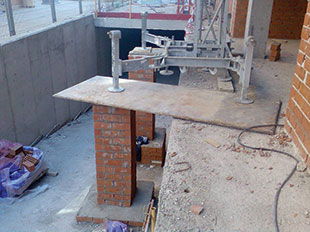
Image courtesy of EZ Scaffold
“It’s very important to remember when you’re working at height that you have to pay respect to any exposed area,” he says.
Setting up and taking down mast climbers and scaffolding also poses hazards to workers. Mast climbers and scaffolding that are incorrectly set up run a risk of collapse. If workers do not follow correct procedures for disassembling mast climbers and scaffolding, these structures may fall on them.
“I will never understand why someone would get on something that could injure or kill them without knowing that it has been set up correctly,” says Bridges.
There are a variety of things construction workers need to do to correctly set up a mast climber, including tying the device off at specified intervals, loading the platform carefully to maintain balance, establishing an appropriate anchor point, etc. Bridges says workers should be trained to safely set up and operate their specific mast climber. Each model from each manufacturer has its own quirks, and contractors should not assume that because employees have worked with mast climbers on other sites that they know how to safely operate the model being used on their current job site.
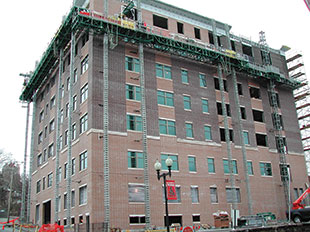
Image courtesy of Hydro-Mobile
In addition to set up and disassembly issues, Stanley says that workers using mast climbers should avoid climbing up the mast to gain access to the mast climber platform, as this puts them at risk. Workers should instead use proper techniques for gaining access to the platform, such as ladders or lowering the platform to their level.
Situational awareness and training
Complacency can also often be the enemy of safety on the job site. Masons often get into a Zen-like rhythm when working on a project. Laying brick after brick for hours on end can cause masons to get into a “zone” where they’re focused on productivity and little else. This can be perilous for masons working on scaffolds and mast climbers, as their focus on work can keep them from recognizing danger.
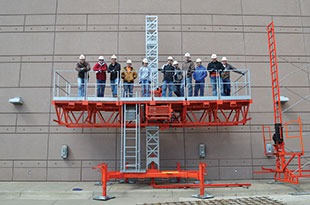
“The busy takes over and it becomes automatic,” O’Shea says. “The message is that you have to be careful. You have to respect that you’re working at height.”
O’Shea says that masons working on mast climbers and scaffolds must take care to remain aware of their surroundings and potential hazards and avoid letting “the busy” take over.
O’Shea also sees a generational gap in perceptions about safety among masonry workers. O’Shea says that younger workers who are trained to modern standards concerning scaffolding and mast climbers often have an easier time sticking to these standards than older workers who may have been working before standards were adopted or before mast climbers became commonplace throughout the industry. These workers may see some safety regulations as an impediment to productivity. He says contractors and manufacturers of mast climbing equipment need to make sure all workers are thoroughly indoctrinated in a culture of safety.
Proper training isn’t just necessary for masons working on construction sites. Contractors and managers also need to know and live by safety standards for scaffolding and mast climbers. Clifford Morris, assistant professor of environmental and safety management at the Pittsburgh State University, teaches students who will be taking leadership roles in the construction industry about safety issues. Morris’ classes use a working mast climber in their studies, and he says real world experiences with the devices are important for construction managers and contractors.
“They’re the ones that will be making decisions,” Morris says. “If they don’t know about the technology, how will they be able to teach their employees about how to safely use it?”
OSHA fines and legal liability
OSHA pays close attention to scaffolds and the organization is starting to turn a more vigilant eye toward mast climbers, Stanley says.
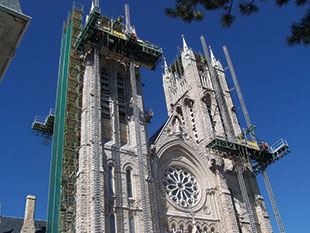
D’Aquino says that citations involving scaffolding, which also includes mast climbers, are the third most common type of citations handed out by OSHA. Penalties for violations are usually assessed up to $7,000 per violation and intentional violations can yield fines around $70,000. In 2013, OSHA fined a New Jersey masonry firm $50,000 for three repeat and five serious safety violations involving scaffolding.
The average penalty for a violation is around $1,000, but penalties can often be reduced if contractors quickly address the cause of the citation.
In addition to fines and penalties, companies that fail to properly train personnel on the safe use of mast climbers and scaffolding and vigorously enforce safety standards can face huge legal liability. A Pennsylvania carpenter recently received a $4 million settlement from contractors he was working for and the owner and distributor of a mast climber related to a fall from the device.
The carpenter was working on a courthouse in Lehigh County, Pa., and fell 50 feet from a mast climber, sustaining injuries to his skull, ribs, pelvis, left ankle and spine. Attorneys with the Saltz, Mongeluzzi, Barrett and Bendesky firm claimed that the carpenter did not have a lifeline to tie fall safety equipment to and that a fall hazard was created by the removal of planks between the platform and the façade of the building.
Bridges says incidents involving falls from scaffolding and mast climbers that result in lawsuits not only highlight the need for proper training, mast climber or scaffolding set-up and proper use of the devices, it also emphasizes the need for contractors to carefully document these efforts.
“If something happens, you better have a good record that you provided training to your employees,” he says.
Mason contractors can prevent injury and avoid significant exposure to legal liability by following OSHA and industry guidelines for proper operation of scaffolding and mast climbers and by providing quality safety training to their employees.
“I could go to 500 jobs where masons are working and if they have the training and safety is being enforced, you’re not going to have a problem,” Stanley says.
Jim Cook is a freelance writer based in Dothan, Ala. He can be reached at jim.cook.is@gmail.com.
In The NewsIPAF Calculates Fatal Injury Rate |
Preliminary fatal injury rate calculations confirm that mobile elevating work platforms (MEWPs, also known as aerial work platforms or AWPs) are one of the safest ways to perform temporary work at height. This latest analysis complements IPAF’s release of the 2014 MEWP-related accident data and indicates that although the total MEWP rental fleet has increased in size, the fatal injury rate has fallen.
Presenting the research, Chris Wraith, IPAF technical & safety executive, noted that IPAF is calculating the fatal injury rate based on the number of MEWP fatalities worldwide against the MEWP rental fleet worldwide and their estimated utilization rate only, as no accurate data is currently available to include the total number of end-user owned machines and their utilization rate. He said, “Comparing fatalities across the whole industry with the total fleet size will most probably bring down the fatal injury rate, so IPAF is currently taking a more conservative approach to the question, ‘How safe are MEWPs?’ and this is an initial attempt to measure and quantify MEWP safety.” Based on the estimated rental fleet size, the average utilization rate and the average days worked per year, the number of days a rented machine was operated per year was estimated at 168.4 million worldwide for 2013. Taken with the 68 reported MEWP fatalities worldwide in 2013, the fatal injury rate (i.e. the number of fatalities per 100,000 days a rented machine was operated) was estimated at 0.040. For 2014, the number of days a rented machine was operated per year was 182.4 million and the number of reported MEWP fatalities was 64, to give a fatal injury rate of 0.035. 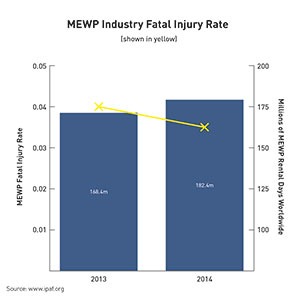 The MEWP fatal injury rate was put into perspective with other existing data on accidents and fatalities worldwide. Information published by official bodies based on accidents as a proportion of workforce was found for France, Singapore, the UK and the US concerning the number of fatalities due to falls from height per 100,000 workers and the number of fatalities at work per 100,000 workers. The comparison with fatal injury rates due to falls from height and fatalities at work showed MEWPs to be a safe way to work at height. In the US for example, the MEWP fatal injury rate per 100,000 of the workforce in 2013 (the most recent year for which data is available) was 0.03, whereas the fatal injury rate per 100,000 of the workforce due to falls from height was 0.4 (the number of fatalities due to falls from height involving MEWPs was excluded from this figure) and the fatal injury rate per 100,000 of the workforce due to fatalities of any kind at work was 3.27 (the number of fatalities involving MEWPs was excluded from this figure). The MEWP fatal injury rate was reviewed against other relevant industry sectors. However, the research found little commonality between industries in the way that fatalities are reported or tracked. All calculations and comparisons have been checked and validated by Ducker Worldwide, a primary research-led industrial market research and consulting company specializing in construction equipment and materials. IPAF’s accident reporting project, launched in 2012, is gradually creating a comprehensive record of known accidents. Newly released figures reveal that there were 64 MEWP-related fatalities in 2014. IPAF’s Rental Market Reports estimate the worldwide MEWP rental fleet at more than 1.1 million (www.ipaf.org/reports). The 2014 accident figures indicate a small decrease from that for 2013, which have been re-adjusted upwards in the light of new information to show 68 MEWP-related fatalities in 2013. This gives a fatal injury rate of 0.035 in 2014 compared to 0.040 in 2013. Analysis of the 2014 data reveals that falls from height and overturn remain the two main causes of fatal accidents. The accident data gathered enables IPAF to improve the content of training programs, to develop technical guidance, to target specific high-risk professions or activities, and to provide research findings used to influence standards. All manufacturers, rental companies, contractors and users are encouraged to report any known accidents (not just fatal and serious accidents) involving MEWPs and MCWPs (mast climbing work platforms) worldwide at www.ipaf.org/accident. This information is used to make the powered access industry even safer than it is today. For more information, visit www.ipaf.org. |
